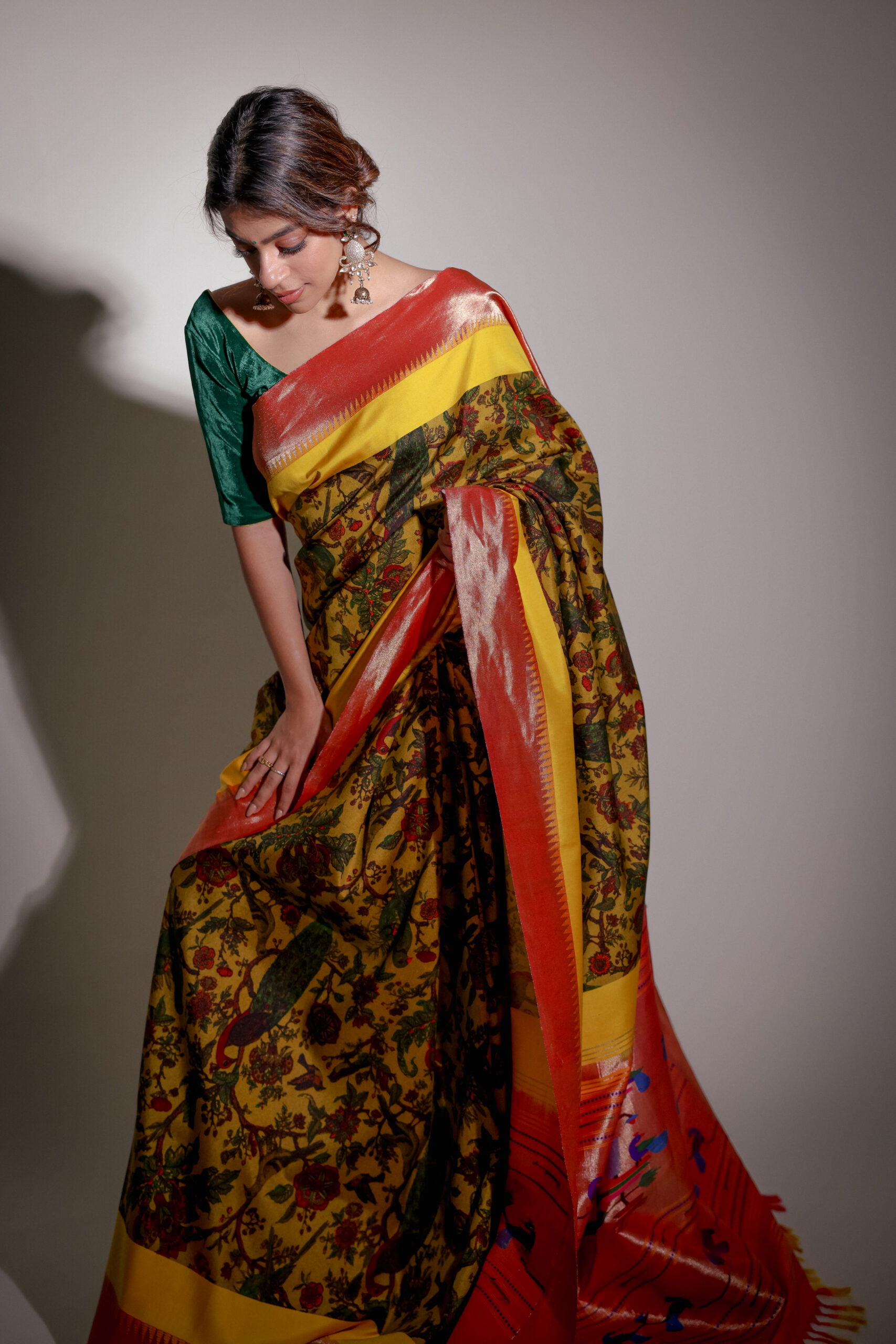BINDU GIRI
Entrepreneur, mathematics enthusiast and a handloom revivalist on her spontaneous entry into the fashion industry and passion for keeping the art of weaving alive, her take on being a modern royal and how she draws her strengths from her roots and metaphorically defines the modern sari, Bindu Giri tells us all in a candid conversation.




1. you hail from the Royal Zamorin family.. What is it like to be a modern royal? And How does this label impact your perception of responsibility, culture, and the like?
Of course, Royals in the historic sense protected and deeply cared for their subjects. Today, my responsibility as a modern royal is to dedicate my efforts to
2. Tell us about your foray into the fashion industry. What has your journey as a business woman been like?
I entered the fashion industry very spontaneously and was a 180 degree turn from my initial path in Finance. Ever since I was little, I had been exposed to the love for textiles through my grandmother. I wouldn’t say that ever left me. Eventually it became a large enough itch that I had to scratch it. What started as a passion project has slowly blossomed into what I would like to think is a small step in a beautiful and swift movement in the handloom revival industry.
a focused subset of the handloom industry & fructify the weaves that were lost along the way.
3. What is the culture of a Sari? How has the representation of a sari evolved over time?
The sari represents fluidity, comfort, and regal effortless beauty all at once. Originating as an unstitched single cloth, it functions as a canvas for creativity. What started out as region specific styling of the cloth, is now draped in a limitless array of permutations and combinations. Becoming a physical emblem of the fast moving world we live in where borders become further blurred.

4. The pace at which the world is expanding on its acceptance and usage of sari is increasing, but is outdone by the pace at which weaver communities are shrinking. What’re your thoughts on this? What would you hope to be the future of local craftsmanship and weavers?
Weavers are currently unmotivated to train their offspring to weave. The craftsmanship & skillset is not getting transferred. Earlier on, weaver families worked as a unit. Fathers and mothers would weave & children would help with the warp & weft, threads for dyeing etc. This way, there is a natural dissemination of knowledge. Today, because of the laws of child labour, none of the children are exposed to the family’s work. While weavers are actually creating pieces that become heirlooms, they don’t see their jobs as prideful ones. Thus, children are sent to jobs that
- They don’t think its a glorified art.
- They don’t see the takers so they think the younger generation has no scope to continue the legacy.
- No one likes to sit at home and work anymore. They think a 9-5 job is ideal.
5. You’re someone with multiple masters in the arenas of business and mathematics, so what brought you into the polar opposite field of fashion?
I’ve always been super analytical so business and mathematics seemed like the most immediate choice. I loved every bit of it and will still chase my children with mental maths if I get the chance. But I’ve also always loved fashion and dressing up since I was very young. I used to design clothes for my younger siblings whenever I had some time to spare, and loved styling my grandmother (and she made it so easy being absolutely stunning).
6. Tell us your design philosophy and design process. What inspires BG?
Simplicity and Heritage.
Like most creatives, sometimes I have absolutely no process. I’m inspired by archives; life before and life now.
7. The narrative of AG is about exploring the past through the lens of the present. Does that resonate with your brand BG?
Absolutely. I think evolving with the world around you is the only way you stay relevant and the craftsmanship stays relevant. It isn’t fair of me to say “Here’s a handloom. Like it is” I have to understand that people want softer saris, experimental colours, creative placements. So to be a purposeful initiator, I must infuse those modern sensibilities into the simple heritage of the past.



8. One of your deepest maternal connections is with your Grandmother. Tell us about her and her influence in your journey.
(A gentle smile sweeps across Bindu’s face).
She was the personification of grace, wit, and benevolence. When I think of my Ammama I think of one petite frame, unassuming but erupting as a force of nature that emanated warmth and light all at once. She instilled my love for textiles and so much more. I’m grateful for her, and I’d like to think that this journey is not just mine, but hers too.
9. Hand craftsmanship in the modern era- what makes you a patron of AG, while working towards growing BG?
AG has taken hand craftsmanship to the next level. She takes it to the next level with a focus on contemporary audiences with that experimental touch. As a simple example, Kantha embroidery, a hand-work celebrated in Bengal, is being used in the most effective manner to cater to today’s global audience. When you say ‘while working towards growing BG’ I have to emphasise that it’s uber comfortable and I tend to wear AG shirt dresses to work all the time.
10. What has been your biggest takeaway on fashion from these years at BG?
India has no dearth of talent. Over the years I’m seeing more young designers with incredible thoughts and ideations coming to life. As a maker, I think the hardest part is to balance invention and relatability. It’s a forever learning process and that’s my favourite thing about my world.
